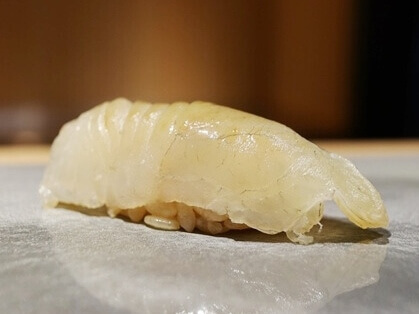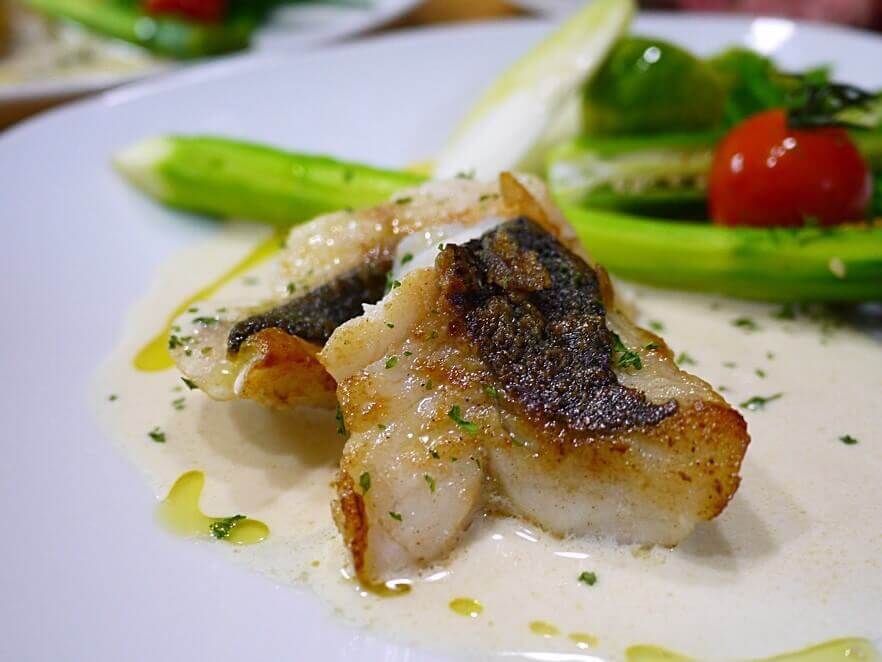In Japan, they say, “Japanese cooking means taking away and Western cooking means adding.” This concept is well-known among Japanese chefs, but it may be difficult for western chefs to understand. This is verified in the way the white Japanese sea bass, the representative fish of summer, is prepared. This is all connected to clearly explaining the irrefutable differences between sushi and western fish cuisine, which also involves differences in cultivated history and culture.
 In the case of Sushi, a representative of Japanese cuisine, the decisive point is to prepare the fish in a way that removes the fishy odor characteristic of Japanese sea bass. At the same time, the finished piece should be a simple dish that can be enjoyed with only a minimal amount of nikiri soy sauce and wasabi, so as not to override the natural refreshing flavor and umami of the fish. It should let the customer imagine sea bass swimming in the summer sea. And yet, the deep flavor required for the dish is successfully brought out using only a balanced combination of vinegar rice, the topping, wasabi and soy sauce. The method is really just to take out the excessive elements of the dish.
In the case of Sushi, a representative of Japanese cuisine, the decisive point is to prepare the fish in a way that removes the fishy odor characteristic of Japanese sea bass. At the same time, the finished piece should be a simple dish that can be enjoyed with only a minimal amount of nikiri soy sauce and wasabi, so as not to override the natural refreshing flavor and umami of the fish. It should let the customer imagine sea bass swimming in the summer sea. And yet, the deep flavor required for the dish is successfully brought out using only a balanced combination of vinegar rice, the topping, wasabi and soy sauce. The method is really just to take out the excessive elements of the dish.
 Meanwhile, the method for making sea bass dishes in French cuisine, representative of western cooking, includes seasoning the fish with salt and pepper and saute in butter, then adding rich, creamy sauce as well as other things like herbs, caviar, black truffles, etc., creating a dish that allows enjoyment of multilayered flavor. This sort of dish beautifully makes up for the flavors that the light, white fish lacks and portrays a flavor with depth through the finished plate over the individual flavor of the sea bass. In this cuisine, it can be said that the cooking method is more important than the raw ingredients. It can be thought of as cuisine that adds many ingredients.
Meanwhile, the method for making sea bass dishes in French cuisine, representative of western cooking, includes seasoning the fish with salt and pepper and saute in butter, then adding rich, creamy sauce as well as other things like herbs, caviar, black truffles, etc., creating a dish that allows enjoyment of multilayered flavor. This sort of dish beautifully makes up for the flavors that the light, white fish lacks and portrays a flavor with depth through the finished plate over the individual flavor of the sea bass. In this cuisine, it can be said that the cooking method is more important than the raw ingredients. It can be thought of as cuisine that adds many ingredients.
Comparing the two, it’s clear that the approaches are completely opposite. Another difference is how the flavors are treated. Flavors perceived through aroma can be described as “aromatic flavor”.
If this fragrant flavor were not important in sushi, then there would be no debate on whether to use wild or farmed fish. For example, sea bream is available both in the wild and as farmed fish. There is not much difference in amino acid composition and umami content between the two. So how is it that farmed sea bream and wild sea bream end up tasting so different? The reason is undoubtedly the aroma. The subtle aromatic compounds, volatile substances carried in the fish’s fat, are what define the essential flavor of the sea bream. Wild fish, having fed on a natural diet and lived in varied ocean environments, develop a more complex and refined aromatic profile. In contrast, farmed fish, raised on controlled feed in uniform conditions, lack this nuance. This means that much of the pleasure of eating sushi comes from recognizing and savoring this delicate aroma.
On the other hand, in Western fish cuisine, the culture is to combine many different aromas, as if composing a perfume, probably because people want complex flavor. In addition, in French and similar cuisines, care to serve dishes at a temperature that is warm, but not hot, in order to bring out the natural flavor of the ingredients. While cooking the dishes, the temperature is strictly controlled so that the components of the ingredients don’t change from the heat, in order to maintain the taste and aroma. This method does not neglect fragrance by any means. In sushi, the fish itself is the centerpiece, with preparation methods designed to remove distractions from its inherent character. In Western cuisine, the plate as a whole is the centerpiece, where the fish is one component in a carefully constructed harmony of flavors.
In either method, the one essential element is this “aroma”. The only true difference is how that is expressed.
[sc_apply url=”https://sushiuniversity.jp/apply/”]
We hope this information will be helpful.

Revision date: August 11, 2025
Share this article